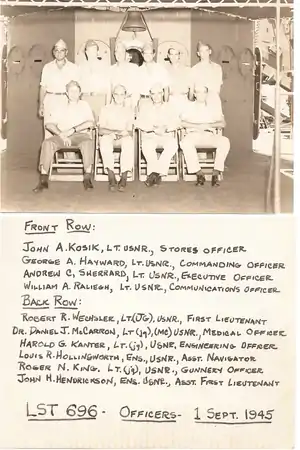 Officers of LST-696 in September 1945
| |
| History | |
|---|---|
| Name | USS LST-696 |
| Builder | Jeffersonville Boat and Machine Co., Jeffersonville, Indiana |
| Laid down | 25 February 1944 |
| Launched | 25 April 1944 |
| Commissioned | 25 May 1944 |
| Decommissioned | 16 July 1946 |
| Stricken | 28 August 1946 |
| Honors and awards | 3 × battle stars |
| Fate | Sold for scrapping, 19 May 1948 |
| General characteristics [1] | |
| Class and type | LST-542-class tank landing ship |
| Displacement |
|
| Length | 328 ft (100 m) |
| Beam | 50 ft (15 m) |
| Draught |
|
| Propulsion | 2 × 900 hp (671 kW) General Motors 12-567 diesel engines, two shafts |
| Speed | 12 knots (14 mph; 22 km/h) |
| Range | 24,000 nmi (44,000 km) at 9 kn (17 km/h; 10 mph) (fully loaded) |
| Boats & landing craft carried | 2 LCVPs |
| Capacity | 1,600–1,900 short tons (1,500–1,700 t) |
| Troops | Approx. 150 |
| Complement | 7 officers, 104 enlisted |
| Armament |
|
USS LST-696 was an LST-542-class tank landing ship built for the United States Navy during World War II. LST-696 was laid down on 25 February 1944 at Jeffersonville, Indiana, by the Jeffersonville Boat & Machine Company; launched 25 April 1944; and commissioned 25 May 1944.[2]
Service history
During World War II, LST-696 was assigned to the Asiatic-Pacific Theater and earned three battle stars for World War II service.[1]
- Morotai landings, September 1944
- Leyte landings, November 1944
- Lingayen Gulf landings, January 1945
Following the war LST-696 performed occupation duty in the Far East until April 1946. She was decommissioned on 16 July 1946, and struck from the Naval Vessel Register on 28 August 1946. She was sold for scrapping on 19 May 1948, to the Bethlehem Steel Company of Bethlehem, Pennsylvania.[2]
See also
References
- 1 2 "LST-696". Dictionary of American Naval Fighting Ships. Navy Department, Naval History and Heritage Command. 2004. Retrieved 12 July 2012.
This article is issued from Wikipedia. The text is licensed under Creative Commons - Attribution - Sharealike. Additional terms may apply for the media files.
.jpg.webp)